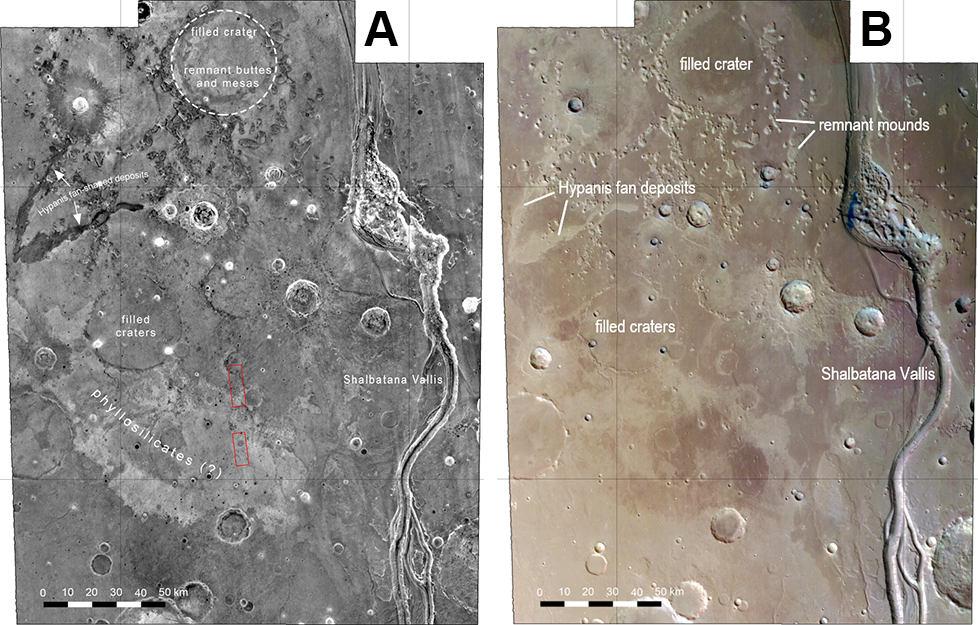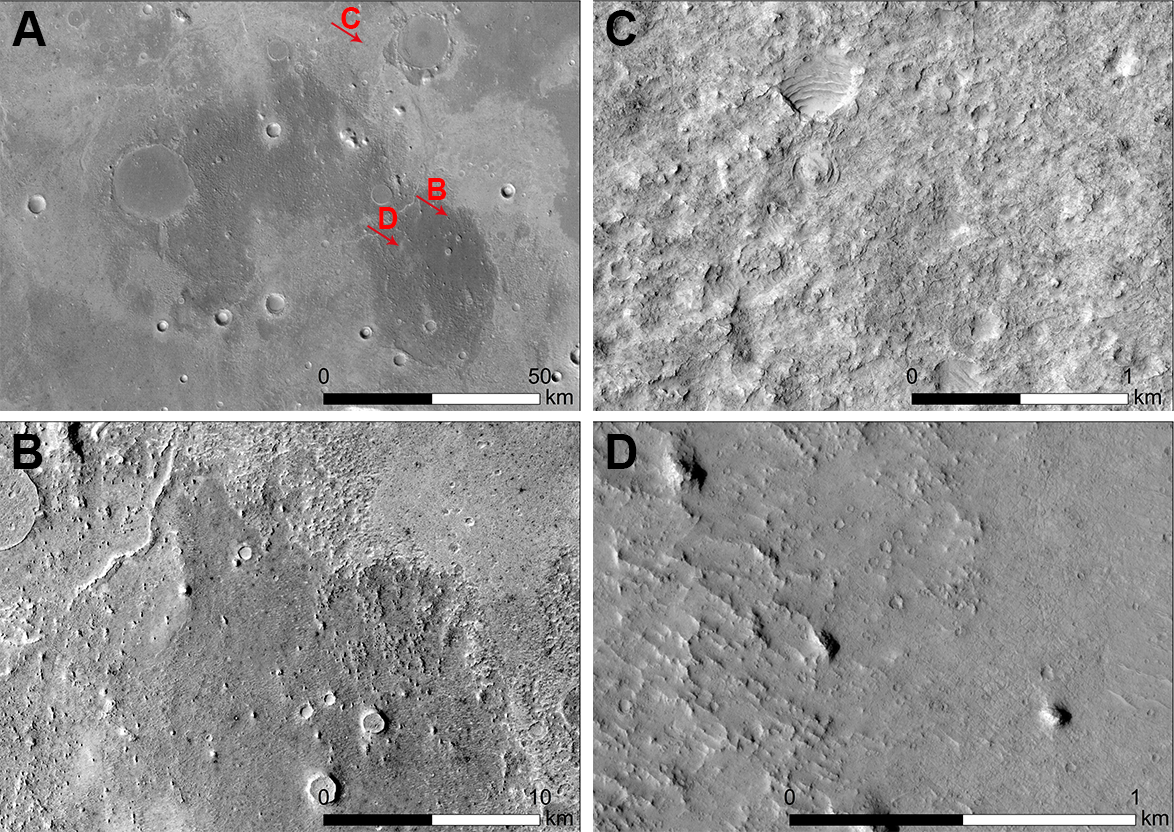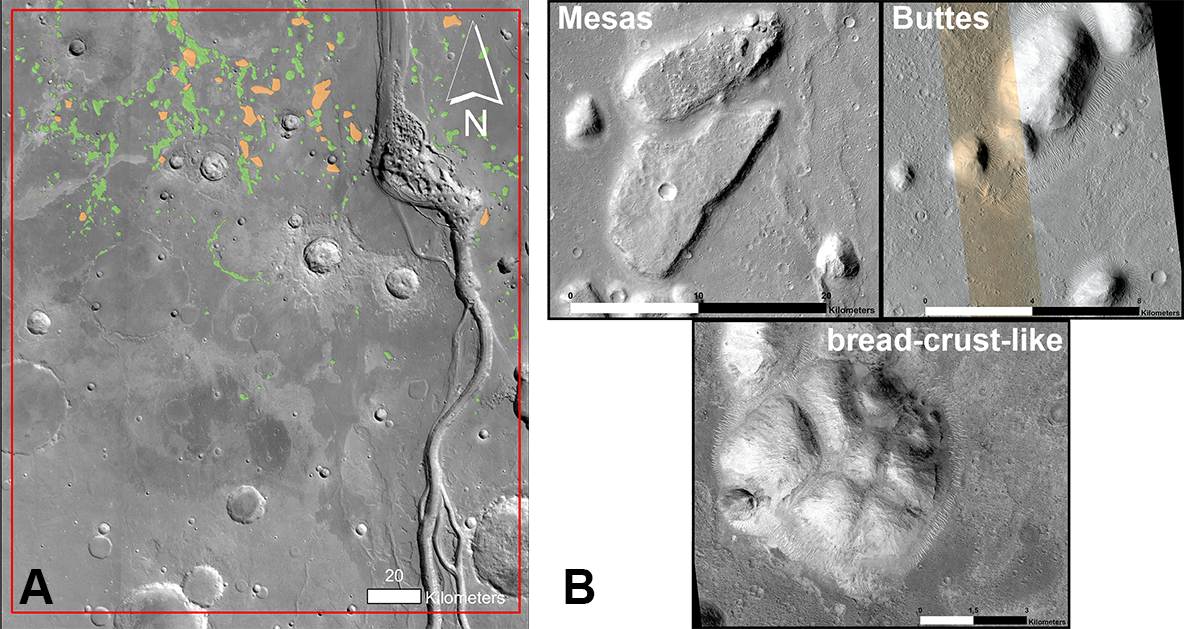- 1University of Münster, Institut für Planetologie, Germany (thomas.frueh@uni-muenster.de)
- 2Institute of Planetary Research, German-Aerospace-Center (DLR), Rutherfordstr. 2, 12489 Berlin, Germany
Introduction: ESA’s ExoMars rover will land in the Oxia Planum (OP) region [1,2], which was chosen for its ancient age, evidence for the sustained presence of water, the presence of layered deposits, and the potential for biosignature preservation [2]. While some of the geological characteristics have been studied in detail [3-5], other aspects are less well understood. In particular, it is unclear if the situation in OP is a unique one, or if the geologic setting is representative for Mars on a regional, or even a global scale. Specifically, the stratigraphic relationship of the geologic units in OP to the nearby ancient impact basin, Chryse Planitia, requires further study. For example, a »bathtub«-like ring of Fe/Mg-rich phyllosilicates around Chryse [6] may indicate that the phyllosilicates at OP reflect aqueous processes that operated in a specific context at basin-scale.
To test the hypothesis that OP is representative for a circum-Chryse geologic setting, we selected a site in northern Xanthe Terra (XT) (~9-13.5°N/315-318.5°E; Fig. 1) to investigate key geologic features and compare them to OP. This site displays several characteristics similar to OP, making it a suitable reference site: The presence of phyllosilicates [7], the proximity to fluvial features [8-10], and the abundance of remnant buttes that are indicative of widespread erosional processes [11]. Here we present preliminary results of our mapping and geologic analysis.
Preliminary Results and Discussion: The study area is approximately 225 × 190 km in size. The general elevation increases in height from north to south from approximately -2,960 m to -1,800 m. Both at OP and XT, the lowland-highland boundary is expressed as a gradual slope rather than a sharp topographic step.

Figure 1: (A) THEMIS nighttime IR and (B) HRSC image mosaics of the study site in Xanthe Terra.
In the northwestern study area, the Hypanis fan represents the arguably largest sedimentary fan deposit on Mars [8-10]. These deposits are finely layered and appear dark in THEMIS nighttime IR images (Fig. 1). Sedimentary fan deposits, while having a smaller extent, are also present in OP at the termination of the Coogoon Valles fluvial system [5,12,13]. Both the sedimentary deposits in XT [8-10] and OP [13] are thought to have a fluvial origin.
Phyllosilicates are widespread in OP [4-6] and are the main target of the ExoMars rover. Apart from their spectral signature, they are also characterized by a bright THEMIS nighttime IR signature and a polygonised texture at HiRISE scale. A global-scale search for chemical alteration signatures revealed the presence of Fe/Mg phyllosilicates in northern XT, marginal to Chryse [4]. As in OP, the phyllosilicate-bearing plains appear bright in THEMIS nighttime IR images (Fig. 1). At least two different units are present in this region. The most widespread is a light and layered unit, which is partly eroded, exposing a darker material underneath (Fig. 2). NW – SE orientated small dunes and periodic bedrock ridges, a type of aeolian erosional landforms which is ubiquitous in the clay-bearing plains of OP [14], are present on top of the darker unit. HiRISE coverage of both units shows distinct polygonised textures. Several inverted craters are present within this two units. The material of these inverted craters differs from both units, and, therefore, represents the remnants of at least one further eroded unit. The phyllosilicate-bearing plains are overlain by a widespread unit, which seems to be present in most of the northern study area.

Figure 2: (A) HRSC mosaic of the phyllosilicate-bearing plains. The erosional contact is shown in (B). (C) and (D) are HiRISE images of the lighter and darker unit, respectively.
The rims of ancient filled craters are outlined by rings of mounds. The diameters of these mounds range from tens of meters to several kilometers. Their appearance is variable and resembles mesas, rounded knobs/buttes, and “bread-crust-like features” (Fig. 3). These mounds are increasing in height and abundance towards north, i.e. towards Chryse. A similar trend of height and abundance was also observed in OP [15]. However, the height of these mounds varies individually. Rounded buttes, for example, can be higher than mesas in their immediate neighborhood. Some mounds show a fine layering, and, in some cases, mounds stand on top of a finely layered basis. The mounds appear dark in THEMIS nighttime infrared images (Fig. 1). Similar mounds are present along the eastern highland boundary of Chryse [11]. The composition of the mounds and their erosional history are not yet clear. The low thermal inertia and the fine layering of some of the mounds, however, favor a sedimentary material. The timing of mound formation relative to other geological units is also still unknown since stratigraphic relationships between these units still seem conflicting.

Figure 3: (A) Mapped mounds in the study area. Rounded buttes are shown in green and mesas in orange. (B) CTX and HiRISE images of the remnant mound types.
Preliminary Conclusions: Northern XT and OP share various geological characteristics (e.g., sedimentary fans, phyllosilicates, remnant mounds) and a comparable location at the lowland-highland boundary at Chryse Planitia. These similarities enable a comparison between both sites and a testing of hypotheses related to the ExoMars rover landing site.
References:
[1] Vago, J. L. et al. (2015) Sol. Syst. Res., 49, 538–542. [2] Bridges, J. C. et al. (2018), LPS XLIX, Abstract #2177. [3] Vago, J. L. et al. (2017) Astrobiol., 17, 471–510. [4] Carter, J. et al., (2013) J. Geophys. Res., 118, 831–858. [5] Quantin-Nataf, C. et al. (2021) Astrobiol., 21, 994-1013. [6] Mandon, L. et al. (2021) Astrobiol., 21, 464-480. [7] Carter, J. et al. (2019) Ninth Int. Conf. Mars, Abstract #6175. [8] Hauber, E. et al. (2009) Planet. Space Sci., 57, 944–957. [9] Fawdon et al. (2018) EPSL, 500, 225–241. [10] Adler, J. B. et al. (2019) Icarus, 319, 885–908. [11] McNeil, J. et al. (2021) LPSC, 52, Abstract #2548. [12] Ivanov, M. A. et al. (2020) Sol. Syst. Res., 54, 1-14. [13] Molina, A. et al. (2017) Icarus, 293, 27-44. [14] Silvestro, S. et al. (2021) GRL), doi: 10.1029/2020GL091651. [15] McNeil, J. D. et al. (2020) LPSC, 51, Abstract #1948.
How to cite: Frueh, T., Hauber, E., Adeli, S., Tirsch, D., and Nass, A.: Northern Xanthe Terra: Update on the Reference Site for the Exomars2022 Landing Site in Oxia Planum, Europlanet Science Congress 2021, online, 13–24 Sep 2021, EPSC2021-615, https://doi.org/10.5194/epsc2021-615, 2021.

